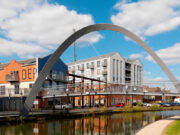The historic city of Cambridge is home to one of England’s two great universities. And like its rival Oxford, it has colleges that date back more than 700 years and some of the great names of learning attached to it.
Built astride the River Cam, it is a city of bicycles, of art and culture, of summer days spent lazing on the banks of the river and a youthful vibe that stands in stark contrast to its venerable buildings.
Sadly, it has the ubiquitous shopping centres that make it resemble many another English town – with the same old shops and chain restaurants and cafes. And it can be very busy with holidaymakers and day-trippers if you catch it on a sunny day, everyone tripping over bikes and locals plugging any number of concerts and shows. But we can overlook all that…
Plan your travel to Cambridge by train. For car hire, book with: Budget, Alamo, Europcar or Sixt. Here are 10 things to see and do in Cambridge:
Go for a punt on the river
Punting on the Cam has been a mainstay of Cambridge life for generations. Choose to take a chauffered tour or have a go yourself, if you have a sense of balance and can cope with the traffic jams on the river on a busy weekend. You’ll get the best views of King’s College Chapel, The Wren Library at Trinity College and the Bridge of Sighs from the water. Several companies are available on the river.
The Backs
The collective name for the series of parks, gardens, bridges and paths that line the river behind the city centre colleges, The Backs are a world away from the noisy shopping streets and car park queues. As with punting, you’ll get some fine views of the historic buildings and everyday Cambridge student life amid the trees and meadows. But bear in mind that not all these green spaces are public and some can only be accessed through the colleges. There are plenty of other green spaces in the city centre, including the charmingly named Christ’s Pieces.
Take in the views from Great St Mary’s Church
The university church was build over the road from King’s College Chapel and the grand Senate House, where graduation ceremonies are held every summer. Dating from the late 15th and early 16th centuries, it has two organs and a tower offering great views of the city. You’ll have to climb 123 punishing and narrow steps to get to the top. A few minutes away is the smaller Church of St Bene’t – the oldest building left in Cambridgeshire, with a stout Saxon tower that includes ready-made holes for nesting owls – in the hope they would repay the thing by killing a few mice.
King’s College
The chapel of King’s College is one of the most recognizable buildings in the world, an extraordinary place of worship dating from the 15th and 16th centuries and one of the finest examples of Gothic architecture that you’ll find anywhere. Its historic stained glass windows and the wood and stone carving are thrilling enough but its the fan-vaulted ceiling that’s the real star of the show. The interior is divided by a dark and wonderfully carved wooden screen summounted by an organ. On display at the high altar is Rubens’ 1634 work Adoration of the Magi while some of the side chapels tell the story of the building’s construction. The building is perhaps best appreciated while listening to one of the regular concerts.
Fitzwilliam Museum
The 19th century building houses art collected by the seventh Viscount Fitzwilliam during his lifetime and which he bequeathed to his old university. The galleries are packed with works from ancient Greece and Rome, Chinese ceramics and works by the greats – Leonardo da Vinci, Titian, Rubens, Gainsborough, Constable and Picasso. The city has several other museums – dedicated to archaeology, zoology and earth sciences. The Whipple Museum of the History of Science is rather dry while the Scott Polar Research Institute hosts the Polar Museum and its collection of artefacts, journals, paintings, photographs, clothing and other materials illustrating polar exploration.
Botanic Gardens
Cambridge has a healthy collection of green spaces but Cambridge University Botanic Garden, which has been open to the public since the 1840s, is a real treat. Its 40 or so acres contain around 8,000 plant species growing outdoors and in glasshouses. It also boasts a lake, a winter garden, rock gardens and a fine array of mature trees. You’ll find it on the pedestrian route from the railway station to the city centre.
Queens’ College
Our favourite among the Cambridge colleges, Queens’ College sits in beautiful grounds by the river and dates from the 15th century. The Old Court and Cloister Court are two of the best medieval courtyards you’ll find anywhere, one with a half-timbered President’s Lodge. There’s also a tower where Dutch scholar Erasmus lived during his stay in Cambridge in the early 16th century. Cross the wooden, or mathematical, bridge for the more grounds and a modern addition to the college. Queens’ is one of the colleges that charges admission – not all do and not all open to the public all the time. If there’s one you do want to visit, check its website first to avoid disappointment. The oldest but smallest is Peterhouse, founded in 1284.
Eat fine food
The Cambridge Chop House on the corner of Kings Parade and Bene’t Street is one of our favourites in the city, with a menu of hearty and traditional English fare. Steaks, pork, suet puddings and so on mean this isn’t the place for committed vegetarians. There’s another branch, the St John Chop House, near St John’s College. Much on the menu is locally sourced.
Corpus Clock
One of the city’s weirder attractions, the Corpus Clock is a sculptural clock at the junction of Bene’t Street and Trumpington Street. Unveiled by Cambridge physicist Stephen Hawking in 2008, it has the world’s largest grasshopper escapement. Mechanically controlled, there are no computers and work and electricity is used only to power a motor that winds the mechanism and powers the blue LEDs that shine behind the slits in the clock’s face.
Take a bike tour
Why sit on a bus when you could see the city on a cycle tour? Being a university town, Cambridge is full of students on two wheels – and they can get where no bus can. Cambridge Bike Tours offers various routes depending on what you want to see and has some electric bikes if you need some help on the way.
Getting to Cambridge:
Public transport. Take the environmentally friendly option – travel by train.
For car hire in the area, try booking with: Budget, Alamo, Europcar or Sixt
















